Related Research Articles

Frank Wilbur "Spig" Wead was a U.S. Navy aviator who helped promote United States Naval aviation from its inception through World War II. Commander Wead was a recognized authority on early aviation. Following a crippling spinal injury in 1926, Wead was placed on the retired list. In the 1930s, he became a screenwriter, becoming involved in more than 30 movies. He also published several books, short stories and magazine articles. During World War II, he returned to active duty. He initially worked in a planning role, but later undertook sea duty in the Pacific, where he saw action against the Japanese in 1943–44 before being placed on the retired list in mid-1945.

John Henry Towers was a highly decorated United States Navy four-star Admiral and pioneer naval aviator. He made important contributions to the technical and organizational development of naval aviation from its beginnings, eventually serving as Chief of the Bureau of Aeronautics (1939–1942). He commanded carrier task forces during World War II, and retired in December 1947. He and Marc Mitscher were the only early Naval Aviation pioneers to survive the hazards of early flight to remain with naval aviation throughout their careers. He was the first naval aviator to achieve flag rank and was the most senior advocate for naval aviation during a time when the Navy was dominated by battleship admirals. Towers spent his last years supporting aeronautical research and advising the aviation industry.

Aubrey Wray Fitch was an admiral of the United States Navy during World War II. A naval aviator, he held important aviation-related commands both at sea and on shore from the 1920s onward. He also served as Superintendent of the United States Naval Academy.
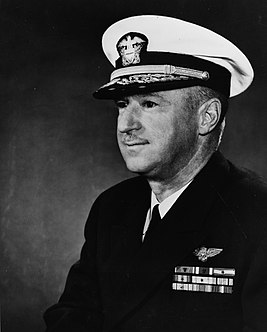
Alfred Melville Pride was a United States Navy admiral and pioneer naval aviator, who distinguished himself during World War II as an aircraft carrier commander.

Theodore Gordon Ellyson, USN, nicknamed "Spuds", was the first United States Navy officer designated as an aviator. Ellyson served in the experimental development of aviation in the years before and after World War I. He also spent several years before the war as part of the Navy's new submarine service. A recipient of the Navy Cross for his antisubmarine service in World War I, Ellyson died in 1928 when his aircraft crashed over the Chesapeake Bay.

Vice Admiral John P. Currier was the 28th Vice Commandant of the United States Coast Guard. He assumed the position from Vice Admiral Sally Brice-O'Hara on May 18, 2012 and was relieved on May 20, 2014 by Vice Admiral Peter Neffenger.
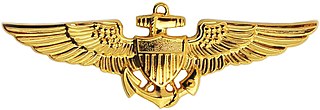
A naval aviator is a commissioned officer or warrant officer qualified as a manned aircraft pilot in the United States Navy or United States Marine Corps. While they complete the same undergraduate flight training as Navy and Marine Corps manned aircraft pilots, and are awarded the same aviation breast insignia, a United States Coast Guard manned aircraft pilot is officially designated as a "Coast Guard aviator".
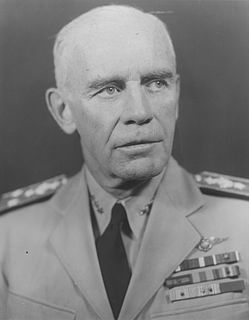
George Dominic Murray was an admiral in the United States Navy and an early naval aviator.

Roy Lee Johnson was a highly decorated four-star Admiral in the United States Navy. A Naval Academy graduate, he trained as Naval aviator and distinguished himself as Air Group Commander during several World War II campaigns.

Patrick Nieson Lynch Bellinger was a highly decorated officer in the United States Navy with the rank of Vice Admiral. A Naval Aviator#8 and a naval aviation pioneer, he participated in the Trans-Atlantic flight from Newfoundland to Azores in May 1919 and was decorated with Navy Cross, the United States military's second-highest decoration awarded for valor.

Maurice Franklin Weisner was a four-star admiral of the United States Navy who served as Vice Chief of Naval Operations (VCNO) from 1972 to 1973; Commander in Chief, U.S. Pacific Fleet (CINCPACFLT) from 1973 to 1976; and Commander in Chief of the U.S. Pacific Command (CINCPAC) from 1976 to 1979.
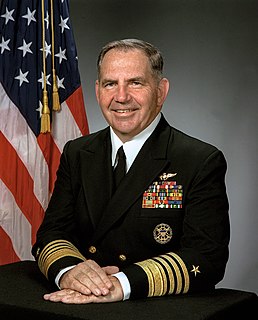
Admiral Stanley Roger Arthur, USN was the Vice Chief of Naval Operations from 1992 to 1995, culminating more than 37 years as an officer in the United States Navy.
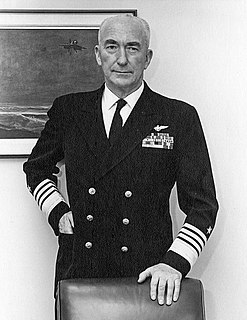
James Sargent Russell was an admiral in the United States Navy.

Richard C. Mangrum was a United States Marine Corps lieutenant general who served as Assistant Commandant of the Marine Corps from 1965 to 1967. Mangrum was a Marine Corps aviator who was awarded the Navy Cross and the Distinguished Flying Cross for his actions during the Guadalcanal Campaign in World War II.
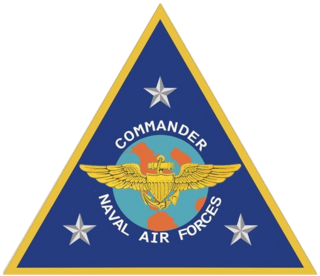
Commander, Naval Air Forces is the aviation Type Commander (TYCOM) for all United States Navy naval aviation units. Type Commanders are in Administrative Control (ADCON), and in some cases Operational Control (OPCON) of certain types of assets assigned to the Pacific and Atlantic Fleets. AIRFOR is responsible for the materiel readiness, administration, training, and inspection of units/squadrons under their command, and for providing operationally ready air squadrons and aircraft carriers to the fleet.

Kenneth Whiting was a United States Navy officer who was a pioneer in submarines and is best known for his lengthy career as a pioneering naval aviator. During World War I, he commanded the first American military force to arrive in Europe for combat. After the war, he was instrumental in development of the aircraft carrier in the United States, where he sometimes is known as the U.S. Navy's "father of the aircraft carrier." He was involved in some way in the design or construction of five of the first six U.S. Navy aircraft carriers, and served as acting commanding officer of the first carrier to enter U.S. Navy service and as executive officer of the first two American carriers. In the earliest days of the U.S. Navy's development of an aircraft carrier force, he led many shipboard innovations still in use aboard carriers today.

In the United States Navy, United States Coast Guard, United States Public Health Service Commissioned Corps (USPHS), and National Oceanic and Atmospheric Administration Commissioned Officer Corps, captain is the senior-most commissioned officer rank below that of flag officer. The equivalent rank is colonel in the United States Army, Air Force, Space Force and Marine Corps.
The Gray Owl Award is presented to the naval flight officer (NFO) on continuous active duty in the U.S. Navy or Marine Corps who has held that designation for the longest period of time.

Scott Harbison Swift is a retired admiral in the United States Navy, serving as the commander of the U.S. Pacific Fleet from May 27, 2015 to May 17, 2018. He previously served as the director of Navy Staff in the office of the Chief of Naval Operations.

Frank Christian Lang was a highly decorated officer in the United States Marine Corps with the rank of major general. A veteran of three wars, Lang began his career as fighter pilot in World War II and rose to the command of Marine Aircraft Group during the Vietnam War. Lang was promoted to the general's rank following the war and held several important assignments including command of 1st and 3rd Marine Aircraft Wings. He completed his career as Deputy Commander, Fleet Marine Force, Pacific in 1978.
References
This article includes public domain information collected from the Naval Historical Center.
- Grossnick, Roy, et al. Appendix 32. "Gray Eagle Award." History of Naval Aviation 1910-1995. Washington, D.C.: Naval Historical Center, 1997.
- Gray Eagles, Naval Historical Center